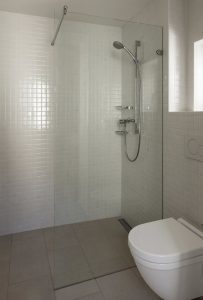Previously we discussed changes you can easily make to your home in order to aid those who would like to age in place. Specifically we focused on fall prevention, one of the leading cause of fatal and non-fatal injuries in seniors. Today we’re going to discuss the major changes that you can make to your home in the interest of preventing falls in your home. Much of what we’re discussing today are suggestions for those who are beginning to think about making their home a space where you can age in place. If you have any questions regarding your particular project please feel free to contact us. We have multiple NAHB Certified Aging-in-Place specialists here at Schrader & Co. to discuss your specific project and needs.
Railings and grab bars are a good first step when looking to modify your home for aging in place, but eventually you may want to look at your overall household floor plan to see what kind of single floor living space (with a full bath) is possible to achieve. Eliminating steps and elevated thresholds in your home will greatly reduce the chance of falls as one gets older.
Many of those who specialize in aging in place remodels suggest that you try to make your home livable on one level. For many people this is not an option. If you cannot get rid of a staircase within your home, but need more than a railing to assist moving up and down stairs a stair glide may be what you need to help. You can determine what will best fit your needs when talking to a Certified Aging-in-Place specialist.

The greatest area of concern in fall prevention is the bathroom. 80% of falls actually occur in the bathroom. Traditional step in tubs and shower stalls pose a great fall risk to many people as they get older, not to mention they might be inaccessible to those with other mobility issues. Zero-entry showers are a great investment for those who want to age in place. They provide a level entryway and they look great too!
Walk in tubs are another option, but they have a few flaws. One has to get into the tub and wait for it to fill if they wish to take a bath, likewise you would also have to wait for the tub to drain before getting out, the whole bathing process can become a bit inconvenient because of this. Walk in tubs do not have a level entry way like that of a zero-entry shower, the threshold that you have to step over is lower than a standard tub wall, but it still poses a falling risk in the long run.
Next time we’ll be talking about other improvements you can make to your home to help you age in place. With a little consideration and anticipation of what your needs may be as time goes on you can live in your home independently and safely for years to come.
